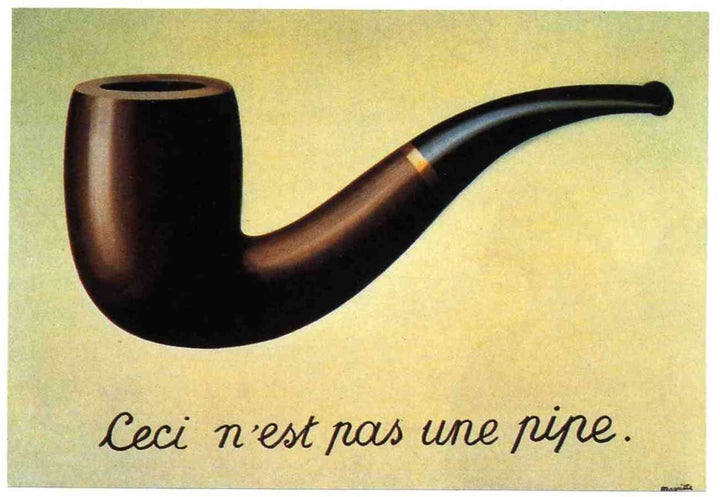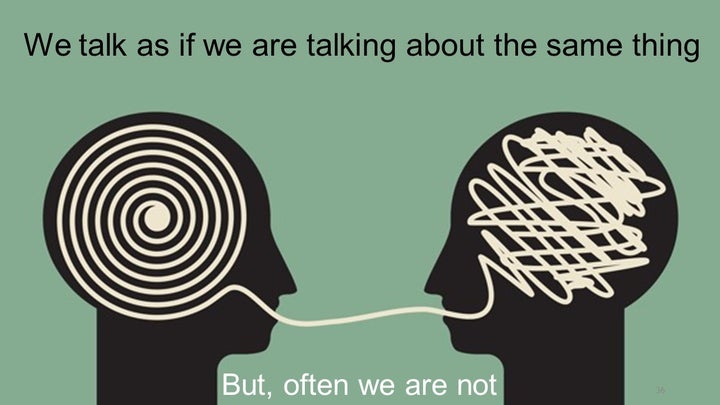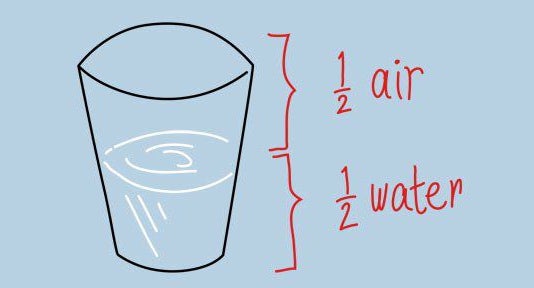Watching a Sean Spicer news briefing from the White House is like watching a high-speed version of a surrealist painter such as Magritte at work. Words, representations, and symbols are all exchanged, but their underlying meaning is lost. What the media people mean is not what the Trump people mean and vice versa. The words have lost their grounding. There is no trust.

“This is not a pipe” -- Rene Magritte, The Treachery of Images, 1928-29)
Alternative facts, fake news, out of context – these are but gentle means of one side saying the other is a bunch of liars. Their truth is not my truth. My truth is THE truth. My G-d.
It is exasperating to watch, and it must be far more exasperating to be a part of. We think we know what we are saying when we use words. They have a meaning. Or do they?

What the current imbroglio between the media and the Trump Administration illustrates is how far adrift from the world of common references and fixed meanings we have come. It is as the late Zygmunt Bauman told us in his 2003 book, Liquid Love. He wrote of people with regard to other people, but his words hold true with regard to words and meaning. Those who bear messages are "despairing at being abandoned to their own wits and feeling easily disposable," and are, therefore "desperate to relate." At the same time, they're "wary of the state of ‘being related' because they fear it may severely limit the freedom they need to relate." They want others to understand the fixed meanings they have in mind but refuse to be limited by telling you just what that fixed meaning is. It instead should be "innately understood."
All well and good when there is enough commonality between messenger and listener for that innateness to happen. A problem when the commonality is lacking. Disaster when there is no trust to allow dialogue to fill the gap.
In academic work, I have written extensively about the Chasm of Dissonance - the gap that occurs when two people cannot find common meaning when making use of the same or similar words (or other representations or symbols). The Chasm Graph is below -- it contains all you need to know to better understand the communications mess we are all watching in DC.

Everyone involved in the saga has a common goal: the efficacious transmittal of meaning. Efficacious is a compound term – it means effectiveness accomplished efficiently. Our President’s tweets are a prime example of hoped for efficaciousness – using fewer than 140 characters to convey an idea which he has deemed important. The character count is a paradigm of efficiency as is the use of Twitter as his medium. A few flicks of the two thumbs and millions read his words. Because he is who he is, the mainstream media then repeat both the tweet and reactions to it. No President before Trump has ever had access to a more efficient medium for his messaging. But, there is a second part to efficaciousness – namely effectiveness. The tweets only look good on this measure to the extent that the audience is composed of “insiders” – those who already agree, believe, and trust in the President (the green line above). For the rest of America (and increasingly the world), the tweets fall far short (where the red arrow points to the black line). Trump’s privileged shorthand is effective only with those who already know the message – like a password which gives you admittance to a private party.
What is going on amongst all the participants in the communications mess is the assertion that expressions occurring in the right-hand third of the graph have well-formed and easily recognized meanings – as if the expressions contained all the information needed for their interpretation -- and they do not. If (and it is a big if) the communicator and the recipient of a message share context, background, mental models, and a common history, the shorthand kind of communication works. When any of these elements are missing, there is a grave danger of misinterpretation. The more these elements are absent, the greater the dissonance between what is being said and what is being heard.

The intellectual and cognitive closed circles of most of the Washington DC-based media and "establishment" means that its participants share many if not most of the requisite four elements. The outsiders of the Trump Administration may share their own elements, but there is little overlap with that of the DC crowd. Shorthand fails. With little trust exchanged between the two groups, there is also little effort to explore why the shorthand failed. Instead, there is name calling and personality slurs. What should be understood as a clash of interpretations is instead presented as a clash between good and evil. Presentations making use of items in the right-hand third of the graph have become useless. No one can hear you, because no one is speaking your language. Even though on the surface you all use the same words.
Bureaucrats, academics, and researchers spend too much time gathering information while in the left-hand third of the graph. Data in our era of big data can be stultifying in its complicatedness and complexity. Those whose job it is to make sense out of it all do what they can to move the communications toward the middle third – where we use metaphors and describe contexts while telling stories. The resonance of those stories – the ability of the listener to put themselves into the story they are hearing – is one of the necessary foundations upon which trust gets built. The other foundations are reliability and predictability. All three are missing when one tries to tell an outsider a story composed from the right third. The commonalities which create the resonance, evoke a sense of reliability, and allow accurate predictions to be made are simply missing.

Consider the squelching of Elizabeth Warren’s talk on the floor of the US Senate during the confirmation vote on Attorney General Jeff Sessions. To those whose focus was the conduct of the chamber (how members interact while in session and how the public sees them interacting), Warren had gone too far. She was reading aloud a letter which specifically made allegations of perfidy regarding Sessions (in the arcane language of the rules she “impugned” him). The question was a narrow one (which implies a role for privileged shorthand) – no impugning. There was to be no “forbidden” means regardless of the “goodness” of her desired end. To those opposed to Sessions, the opposite standard applied – the ends justified the means. Worse, who were these old white men to demand that a liberal woman quoting a prominent black female be quieted?
When questioned the next day, Senators who voted to quiet Warren spoke of the need for decorum and the hypocrisy of greeting someone as a colleague for more than twenty years but allowing their character and person to be impugned. Those who supported Warren spoke of her role as a female, of the fact that she was quoting Coretta Scott King, or of how “evil” Sessions was. These stories had no common ground.
The same can be said of President Trump’s seeming obsession with voter fraud. The man spent an entire election campaign surrounded by opponents who openly spoke of doing anything they could to keep him from first the nomination and then the presidency. Stories of rigged votes abounded. Add in a key piece of data: Trump believes we all should have an identity card. The fact that we don’t and that there is no effort made at most polling stations to verify that a voter is who they say they are gives credence to his belief in potential fraud. It fits together. It resonates. It makes sense.
To the other side, the absence of any data suggesting that fraud happens is enough. But they too have a key piece of background data: they are opposed to the requirement that every American have an identity card. To concede that one needs to prove who you are in order to vote is to concede that such a card might make sense.
Those who want our president to seem more “presidential” are using their own shorthand to guide them in how they filter and interpret what they see. It is the opposite of those who want to “drain the swamp” and upset the system. They see change. The establishment sees chaos.
Movement away from the chasm requires that both sides be willing to place their words in context and take the time to tell the kind of stories which resonate with the others. Twenty-one days into a Trump Administration that willingness is rare. Let us hope we can say differently in a few months.
Change will happen regardless. But better with soothing stories rather than evocations of the fall of Rome.
The glass, you see, is always full — no matter what shorthand folks use to tell you otherwise.

